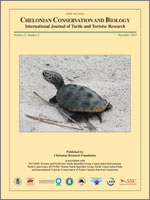The crawl to the sea of freshly emerged hatchlings is a critical period in the life cycle of turtles, although it is short compared with their life span. Hatchlings face predation, human poaching, and heat stress. We examined the crawling behavior of hatchling olive ridley (Lepidochelys olivacea) sea turtles at an arribada beach at Ostional, Guanacaste, Costa Rica. We address the following: 1) How long does it take hatchlings to reach the sea? and 2) What factors affect the time required to reach the sea? We were particularly interested in the aspects that increase their success at reaching the sea, and timed hatchling movement on an experimental grid, and for those emerging naturally from nests. Except when the beach was guarded by villagers, black vultures (Coragyps atratus) were present all the time and captured nearly all the hatchlings emerging from first light (0500 hrs) until dark. Overall, the mean time to reach the sea was 19.2 min (SE = 0.3), mean distance was 27.7 m (SE = 0.5), and mean time to travel 1 m was 54.2 sec (SE = 1.0). For all hatchlings (n = 951), 76% of the variation in time moved/meter was explained by distance to the water, emergence order, type (experimental vs. natural emergence), sand temperature, number emerging/nest, and date. Hatchlings that were picked up (either experimentally or by villagers) moved faster when replaced on the beach than those that were not touched. Many of these same factors explained variation in the time required to crawl the first 5 m from the nest and the time required to reach the water. For all hatchlings the time required to crawl to the water 1) decreased with increasing sand temperature until the sand reached 36°C, when speed increased (hatchlings were heat stressed); 2) decreased with time of day until 0800 hrs, and then it increased as the sand temperatures increased; and 3) generally increased with number of hatchlings that emerged/nest. For hatchlings emerging naturally (n = 841), emergence order, time of day, temperature (either sand or air), tide, and number of hatchlings that emerged/nest significantly entered models explaining the time required to go different segments of the path to the sea. Hatchlings that emerged first moved faster, and the last to emerge moved slower, than did those emerging in the middle.
How to translate text using browser tools
1 December 2014
Factors Affecting Locomotion in Olive Ridley (Lepidochelys olivacea) Hatchlings Crawling to the Sea at Ostional Beach, Costa Rica
Joanna Burger,
Michael Gochfeld
ACCESS THE FULL ARTICLE
Cheloniidae
conservation
Costa Rica
Hatchlings
Lepidochelys olivacea
locomotion
marine debris





